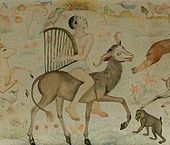Orpheus with the animals
Orpheus with the animals is the title of a mural created in 1930 by the painter Anita Rée . It was executed with tempera on plaster in outline painting and is on a wall in the gymnastics hall of the former girls' school in Caspar-Voght-Straße in Hamburg-Hamm , today's Fokine-Studio of the ballet school of the Hamburg Ballet .
description
Adapted to the original function of the room as a gymnastics room, Anita Rée thematized music and movement based on the Orpheus myth . The spatial conditions were included in the execution, for example Orpheus, riding on an antelope-like animal , stands centrally above a central door. The by him with song and lyre expressed pain of loss of Eurydike is from a plurality of fantastic animals, exotic added such as domestic and wild animals, they turn to the lamenter to, surround him and form a moving fluidized within a landscaped sheet . The entire mural is painted in delicate colors.
background
The result is the image under a of the former Hamburger chief architect Fritz Schumacher initiated and the local art Care Commission carried out arts funding under the title murals in Hamburg state buildings , which should help with an emergency program 1929-1932 artists through existential crises. A total of 26 orders were placed with 16 artists for interior design in new public buildings, primarily schools. The special attraction consisted of the large areas to be designed, which made it possible to try out the mural painting, which was much discussed in the 1920s. Orpheus with the animals was, after the design of a conference room in the Uferstrasse vocational school with the picture The clever and the foolish virgins , the second commission to the artist in this program.
The work is received as an appeal to mutual tolerance and peaceful coexistence of different temperaments and juxtaposed with the reality of the 1930s: “For the Jewish painter, who had been exposed to public attacks by the brown press for a long time, the mural became a symbol of her retreat into one Ideal world. "
Destruction and restoration
Even before the National Socialists came to power, the mural was vilified as " degenerate " on the one hand , but attacked in particular because it was made by a Jewish artist. In 1937 it was painted over. In 1954 it was exposed again and poorly restored. On July 30, 1954, it was listed as a historical monument. To protect it, however, it was covered with wooden panels . When the school was converted into a ballet center from 1987 to 1989, the picture was exposed again and restored again.
Individual evidence
- ↑ Maike Bruhns : Art in the Crisis. Hamburg Art in the “Third Reich” , Dölling and Galitz Verlag, Munich 2001, ISBN 3-933374-94-4 , p. 41
- ↑ List of monuments of the Free and Hanseatic City of Hamburg, as of April 13, 2010 (PDF; 915 kB) p. 40 ( Memento from June 27, 2011 in the Internet Archive ) (PDF; 915 kB), accessed on December 28, 2011
- ^ Hamburg Ballett: Ballettzentrum ( Memento of November 3, 2011 in the Internet Archive ), accessed on December 28, 2011

